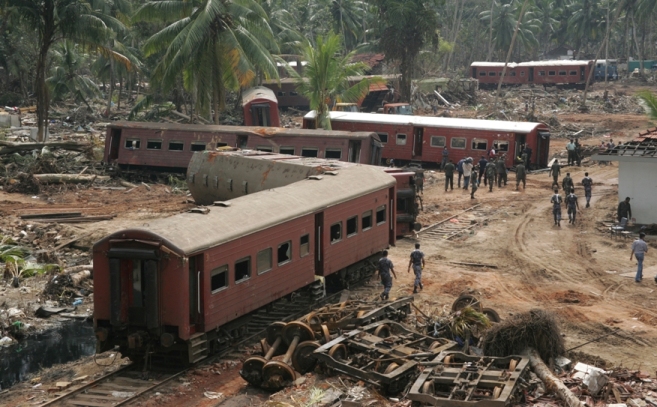
We tend to think of trains and railways as solid, tough objects. When the Asian Tsunami’s killer waves started rolling in without warning, the coastal residents of Telwatte and Peraliya areas in southern Sri Lanka thought a passing train offered them relative safety. They were dead wrong…
The train’s many tons of steel were no match for the enormous seismic energy that the sea waves were transmitting that day. There is no precise estimate of how many people perished on that train, ironically named Samudra Devi (Queen of the Sea) on the morning of 26 December 2004. The estimate ranges between 1,500 and 2,500 – some bodies were never recovered and washed into the sea. They joined a total of nearly 40,000 people dead or missing in Sri Lanka.
This is how the Wikipedia introduces the incident: “The Queen of the Sea rail disaster, the greatest train crash in railroad history, occurred when an overcrowded passenger train was destroyed on a coastal railway in Sri Lanka by the tsunami which followed the 2004 Indian Ocean Earthquake. Up to 2,000 people were killed, making it the world’s worst railway accident and eclipsing the previous record set by the Bihar train disaster in India in 1981, when a train had derailed and fell off a bridge, drowning about 800 people.”

This is what he says about the train tragedy, which sounds every bit gripping like a disaster movie script (but alas, was every bit real):
“The railway authorities realise that one of their trains is moving down south, towards a risk prone area. They attempt to call the railway stations en route. The train is parked at the Ambalangoda railway station, when the station master’s phone rings constantly. Nobody answers it. Both the station master and his deputy are busy supervising the unloading of some goods from the train. By the time they receive the message, the train had already left the station. They do not have any way of issuing a warning, as the engine drive does not have a mobile phone.
“The train stops sometime later, in the middle of a village that had already been hit by the first waves. Those who are running for their lives assume the train to be a shield against the waves. They are wrong. The next waves hit the train, carrying it away like a child’s toy. The railway tracks get crumpled like a Möbius strip. If it can be called a railway accident, this would have been the worst train accident the world had ever witnessed. It alone costs more then 2,500 lives. Perhaps many of those lives could have saved if only the engine driver has been given a mobile phone.”
We didn’t hear of any responsible official resigning or being sacked even after such massive bungling. But now Sri Lanka Railway has the dubious distinction of allowing the biggest train disaster to happen, which could have been prevented with quick thinking and action. Think about this before you next board a train anywhere in Sri Lanka…
Read full chapter: Nobody told us to run, by Chanuka Wattegama

Thanks for providing info on this disaster. I had not heard about it. It is such a shame that something so simple as the driver having a mobile phone could have saved many lives, or even someone answering the station phone before the train left to its doom.
I can remember there was at least one train accident in UK or Europe where investigations showed it was cause by driver texting on his cell phone while trained moved at high speed. So giving drivers cell phones is not going to prevent all accidents.
You you should edit the webpage name title Asian Tsunami+5: How a packed train headed to disaster with no warning… Moving Images, Moving People! to something more specific for your subject you create. I enjoyed the blog post withal.